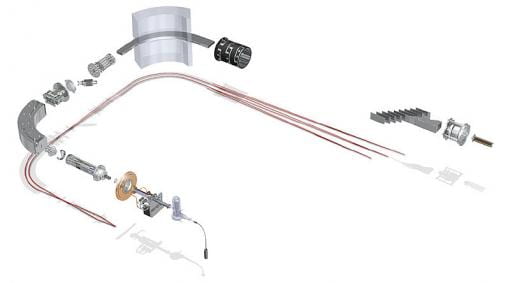1. Thermo Scientific Neptune Plus Multi-collector Inductively Coupled Mass Spectrometer
The Thermo Scientific Neptune Plus is a doubly focusing plasma source mass spectrometer, which allows simultaneous multi-collection to obtain high precision isotope ratio measurements. The Neptune Plus is equipped with a jet interface pump, which enhances the ion transmission in comparison to a standard pump. The Neptune Plus at Brown University has ten Faraday cups, out of which eight are movable (Center and L5 cups are not movable), three SEMs (one is attached to the Center cup and two are attached to L5 platform) and five CDDs. Two CDDs on the low-mass side are attached to the L5 platform; of the three CDDs on the high-mass side, one is attached to the H3 and two are attached to the H4. CDDs on the high-mass side are movable with the high cups whereas CDDs on the low-mass side and all SEMs are fixed.


One of the amplifiers in this Neptune Plus can be connected to a Terra-Ohm feedback resistor (1012 Ω) in order to narrow down the measurement gap between the ion counters and the faraday cups. While the 1012 Ω feedback resistor increases the amplifier gain by a factor of 10, in comparison to a 1011 Ω feedback resistor, the amplifier Johnson noise for 1012 Ω feedback resistor increases by only √10, therefore yielding a theoretical gain of √10 in signal-to-noise ratio. One of the amplifiers in this Neptune Plus can also be connected to a 1010 Ω feedback resistor, increasing the dynamic range up to 500V. This Neptune Plus has two RPQ energy filters resulting in high abundance sensitivity.
2. Thermo Scientific X-series-2 Inductively Coupled Mass Spectrometer
X-series-2 is a single collector quadrupole inductively coupled mass spectrometer capable of measuring concentration for most of the elements in the periodic table. The Peltier cooled spray chamber of the X-series-2 provides enhanced sensitivity and reduced polyatomic interference. This X-series-2 is equipped with collision/reaction cell technology, which uses a gas mixture of 7% H2 in He. In addition to the collision/reaction cell technology, X-seies-2 uses an energy filter to reduce the polyatomic interferences.
3. Photon-Machines Analyte G2 Laser
Analyte G2 is an 193 nanometer wave-length equipped excimer (ArF) laser ablation system. It allows us to perform an in-situ analysis on a solid sample with a beam diameter ranges from 3µm to 160 µm. Analyte G2 is equipped with a 2-volume dual flow sample cell providing faster entraintment of the ablated matartial to the plasma as well as providing faster wash out. The sample chamber (see ppicture) has positions for multiple sample holders – two standard thin sections, three 1 inch diameter discs and two 0.5 inch diameter discs. Thelaser ablation system could be coupled to the Neptune Plus MC-ICP-MS and the X-series-2 quadrupole ICP-MS for in situ isotope ratios and elemental concentration measurements, respectively.


Image above: Thermo Scientific Neptune Plus Multi-collector Inductively Coupled Mass Spectrometer, Thermo Scientific X-series-2 Inductively Coupled Mass Spectrometer and Photon-Machines Analyte G2 Laser
4. Pico Trace Clean Lab
This facility houses a state-of-the-art metal-free Pico Trace Clean Lab, which has an air lock, a weighing room and a main working area. The weiging room and the main working area are positively pressurized. The main working area (class 100) has seven HEPA filtered horizontal laminar flow workstations (class 10), allowing us to perform ultra-low blank chemistry. This clean lab is equipped with five Teflon coated hot-plates, two sub-boiling acid distillation systems (one from Pico Trace and one from Savillex), a high precision balance from Metler Toledo and a Millipore water filtration system (Elix 10 and Element) supplying > 18 MΩ water.





5. Electron microprobe
The deartment houses an electron microprobe facility. The details of the probe facility and the contact can be found in this link:
http://www.geo.brown.edu/research/Boesenberg/microprobe.html